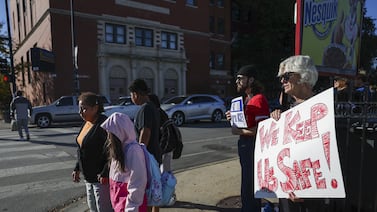In a year marked by major education disruptions as the coronavirus pandemic gripped New York City, graduation rates continued a steady uptick in 2020, reaching 78.8%, according to data released Thursday by the state education department. That was 1.5 percentage points higher than the prior year.
Though more students are earning diplomas, it’s not clear whether that means they are learning more while in high school. The pandemic forced major changes in graduation requirements this year, with the state suspending its Regents exit exams — a rite of passage for more than a century. That’s on top of a steady stream of other reforms in recent years that have opened more pathways for students to earn a diploma.
Still, last year’s graduation rate provides an early glimpse into how students are faring in the fallout of the ongoing health crisis, in a city that became the global epicenter of COVID-19 last spring. Many of the other measures commonly used to gauge student progress were wiped out in response to the pandemic, with standardized exams canceled and traditional grades suspended.
New York City officials cheered the increasing graduation rate and pointed to supports given to the class of 2020 to help students earn diplomas in an unprecedented year.
“No matter the circumstances, New York City students continue to make record progress and exceed our expectations,” said Schools Chancellor Richard Carranza.
When the pandemic forced New York City schools to close in March, many seniors had likely already accumulated the Regents needed to graduate. Students can begin taking the exit exams in seventh grade. But an estimated 8,000 seniors last year, or 13.5%, hadn’t yet fulfilled their Regents diploma requirements, and they received a waiver to graduate, using coursework grades or other measures instead.
State education department Commissioner Betty Rosa acknowledged that canceling Regents exams were a factor in increased graduation rates, “but we cannot say to what extent” since it’s impossible to know how many students would have ultimately passed their tests.
Exemptions were also likely a factor in the smaller number of students using alternate pathways to earn a diploma, state officials said. Students can graduate by substituting a social studies exit exam for another one in math, art, or career and technical education, or take assessments in four languages other than English. The number of students graduating through these pathways was down by 11,173 across the state, representing a 15% decrease from the previous year. In New York City, 2,438 students, or 4.2% used an alternative pathway to graduate — down about 2 percentage points from the previous year.
State officials have not yet said whether they will cancel the Regents this spring. The January exams have already been canceled, as many of the same challenges persist from the end of last school year. New York City’s high school buildings remain shuttered, reliable internet access is still lacking for many students, and coronavirus cases are climbing.
“We will continue to have internal discussions and look at all the options,” Rosa said. “No decision has been made but knowing that we are in January, we are looking at trying to make this decision as soon as possible.”
The historic move of waiving the Regents exams could help inform a long-running debate over the future of using exit exams in New York. The state’s graduation requirements are among the toughest in the country, and research has generally found that exit exams increase dropout rates but don’t increase student achievement. Conversations in school districts across the state about the future of graduation requirements came to an abrupt halt when the coronavirus hit. Advocates are eager for those discussions to kick off again.
Ashley Grant, director of the Postsecondary Readiness Project at the nonprofit Advocates for Children, said she hopes the state education department decides to waive Regents exams this year, “to ensure that no student loses their chance to graduate due to COVID-19.” More than 1,500 parents have signed an online petition calling for such an extension.
“This last year of Regents exemptions shows that there are other ways to show readiness for graduation, and New York is a real outlier using this exam,” Grant said.
Others have warned that it’s important to make sure that vulnerable students don’t get pushed towards less rigorous pathways to graduation. Advocates at the Education Trust New York pointed out that districts serving large numbers of Black, Latino, and low income students had higher numbers of students graduating without Regents exams.
“The disproportionate use of these exemptions raises questions about whether students are receiving the knowledge and skills to be successful in colleges and careers,” said Francisco Araiza, director of policy and research at Ed Trust. “We’re concerned about that.”
Mirroring national trends, the percentage of New York City students earning a diploma has been on an upward climb since 2005, when fewer than half of high school seniors graduated in four years. Across the state, the graduation rate increased to 84.8%, a gain of 1.4 percentage points.
But glaring racial disparities continue. At 75.9%, graduation rates for Black students students in New York City was almost eight percentage points lower than their white peers. That is the largest gap between Black and white students among the state’s top five biggest school districts. For Latino students in New York City, the graduation rate was 74.1, or almost 10 percentage points below those who are white. About 89.5% of Asian students in the city earned a diploma.
The graduation rate for students with disabilities was 52.8%. For those learning English as a new language, it was 45.7% — an increase of 3 percentage points.
Statewide, graduation rates for some of the most vulnerable groups of students climbs when they are given an extra year of two to graduate. Typically, students can continue working towards their diploma until they are 21 years old. Last year, the state made accommodations for overage students to continue progress towards graduation given the disruptions of the pandemic. No decision has been made this year about those students.
But Grant, of Advocates for Children, said it’s more important than ever to allow them more time to graduate, given the likelihood of going through an entire school year upended by the virus.
“It’s a group of students for whom this is a huge deal,” Grant said. “To lose the chance to graduate would be awful.”





